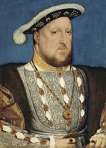
The education of Mary I was influenced mainly by her mother and her tutor, Juan Vives. They expected a lot from her – she was not taught only feminine pastimes, but also how to rule a country.[i] Mary had experience in ruling a court and country from a young age, since she was Princess of Wales until such a time as Henry VIII had a male heir, so she took up residence in that country. It was an unusual education for a woman, even for a princess, but Katherine’s own parents were unusual in that respect.
Katherine knew that women could rule a country, as her mother Isabella I of Castile had done in Spain, and Mary came to believe that one day she would be Queen and rule England as her grandmother had ruled Spain.[ii] Katherine was more closely involved in Mary’s childhood and education and so she became the primary influence on her daughter. With the death of Katherine’s father, Ferdinand II of Aragon, Katherine transferred all of her familial affection and loyalty to Mary.[iii] As Mary was Katherine’s only surviving child after a number of stillbirths and miscarriages, it was no wonder that they were very close.

In summer 1531 Katherine of Aragon was sent to The More and Mary to Richmond. They would never see each other again.[vi] There isn’t really any doubt that this made Mary even more devoted to her mother because of the hardship she was put through. Henry knew how much the separation would hurt them both, and hoped that they would capitulate. Mary’s defiance over the divorce stemmed from Katherine’s courage, and Mary refused to give in when her mother was fighting so hard for her rights.[vii] She gave in after Katherine’s death as there was a lack of international support. She didn’t really have a choice, as she had no one to fall back on. Katherine continually supported Mary through letters and messages and she took her mother’s messages to the heart.[viii] Katherine assured Mary that Henry still loved her and wouldn’t kill her, and that she should obey the king as far as possible, except in issues which touched her conscience.
Mary trusted people during her reign who had supported her mother or herself, or whose parents had done the same. For example, Henry Bedingfield who looked after Princess Elizabeth while she was under house arrest in 1554 was the son of Katherine of Aragon’s steward.[ix] Mary trusted Catholics, and not really any of her father’s or brother’s councillors and supporters. Catholics who had previously fled the country because of their religion and / or their support for Mary returned when she was on the throne. When Mary was on the throne there was a printing in English (the first) of one of the works of her tutor, Juan Vives, called The Office and Duetie of a Husband. In it, Vives wrote about Katherine in terms meant to flatter Mary. He writes that Katherine suffered so much and with a good spirit, and Mary should be proud to be her daughter.[x] What is particularly interesting about this publication is that the work was actually written and first published in Spain when Katherine of Aragon was in the midst of the divorce from Henry VIII. However, it wasn’t published in England until Mary was on the throne because it was too contentious.

Mary and Katherine’s relationship is one of the defining ones of the 16th century because it was so unusual, and took place in unusual circumstances. Mary was stuck between her parents in the break-up of their marriage, and her own position was so insecure until Henry VIII restored her in the succession behind her brother, Edward, and in front of her sister, Elizabeth. When Mary took the throne, one of the first things she did was to make her mother’s marriage to her father legal, and so make herself legitimate. This epitomises the relationship between mother and daughter – Mary wanted to put it right as soon as she could.
[i] Anna Whitelock, Mary Tudor: Princess, Bastard, Queen (Random House, 2009) p. 22
[ii] Ibid, p. 21
[iii] Antonia Fraser, The Six Wives of Henry VIII (Phoenix Press, 2002) p. 92
[iv] Whitelock, Mary Tudor, p. 55
[v] David Starkey, Six Wives: the Queens of Henry VIII (Vintage, 2004) p. 599
[vi] Ibid, p. 443
[vii] Alison Weir, The Six Wives of Henry VIII (Random House, 1997) p. 260
[viii] Peter Ackroyd, Tudors (Macmillan, 2012) p. 91
[ix] Whitelock, Mary Tudor, p. 242
[x] Betty S. Travitsky, ‘Reprinting Tudor History: the Case of Katherine of Aragon’, Renaissance Quarterly, 50 (1997) pp. 164-174, p. 171

